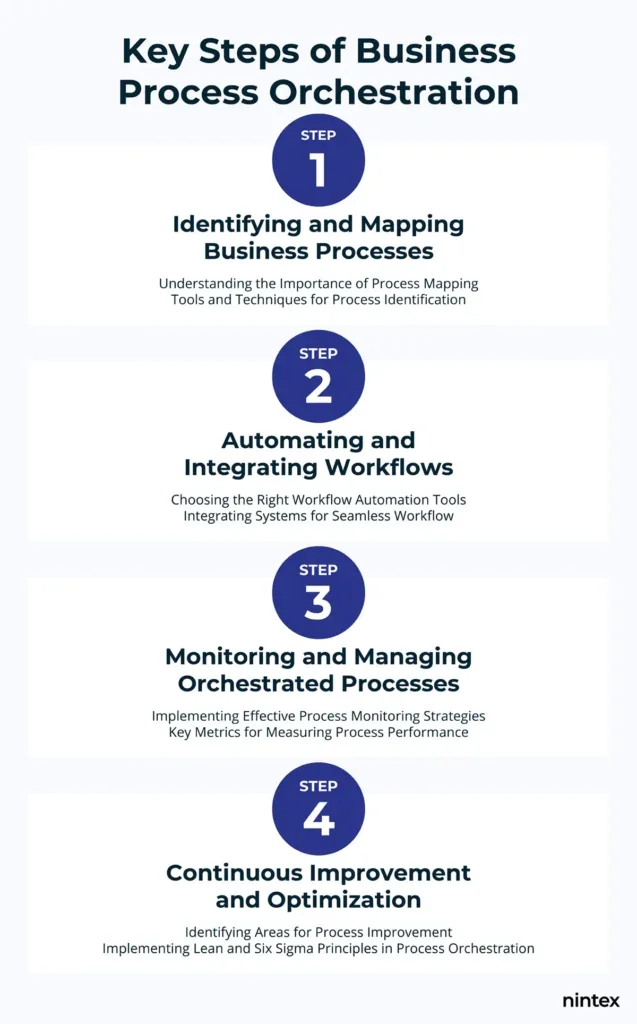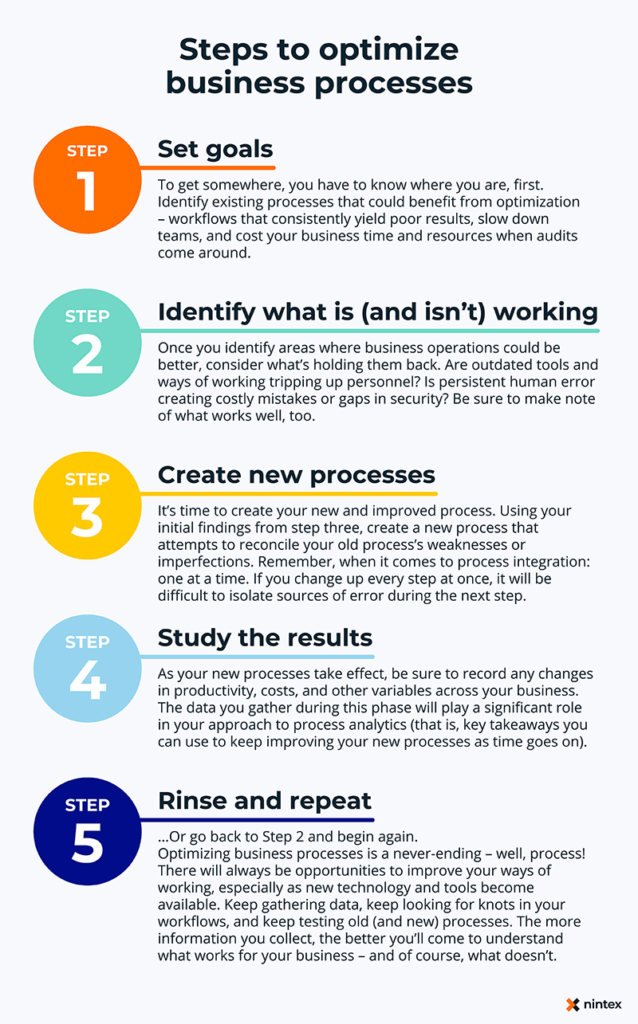Could your business could run more smoothly if everything worked together more seamlessly? Seems like a no-brainer.
Business process orchestration (BPO) refers to the coordination and automation of various business processes to achieve seamless workflows and optimize efficiency. It involves the integration of different systems, applications, and people to streamline operations and ensure smooth execution. By automating repetitive tasks, connecting process steps, and integrating disparate systems, business process orchestration enables organizations to enhance productivity, reduce errors, and improve customer satisfaction.
Defining business process orchestration
Business process orchestration involves designing and implementing a series of interconnected tasks and workflows to achieve specific business objectives. It encompasses the coordination of people, systems, and data to ensure that processes are executed efficiently and in a timely manner. Through automation and integration, business process orchestration eliminates manual handoffs, reduces delays, and minimizes the likelihood of errors, resulting in improved overall performance.
Key benefits of business process orchestration
Implementing business process orchestration offers several advantages for organizations. First, it enhances operational efficiency by automating repetitive tasks, freeing up valuable time for employees to focus on more critical activities. Second, it improves process visibility and control, enabling organizations to monitor and manage workflows effectively. Additionally, business process orchestration promotes collaboration and seamless integration between different departments and systems, fostering better communication and coordination.

Step 1: Identifying and mapping business processes
To successfully implement business process orchestration, the first step is to identify and map out existing business processes . This involves understanding the various activities, dependencies, and stakeholders involved in each workflow. Process mapping allows organizations to visualize the current state of their processes, identify bottlenecks or inefficiencies, and make informed decisions regarding optimization and automation.
Understanding the importance of process mapping
Process mapping is crucial in business process orchestration as it provides a visual representation of workflows, highlighting the sequence of activities and their interconnections. It helps organizations identify redundant or unnecessary steps, streamline processes, and improve overall efficiency. Process mapping also aids in identifying opportunities for automation and integration, enabling organizations to optimize their operations effectively.
Tools and techniques for process identification
There are various tools and techniques available for identifying and mapping business processes. Organizations can use flowcharts, swimlane diagrams, or process modeling software to visually represent workflows. Additionally, conducting interviews and workshops with process owners and stakeholders can provide valuable insights into the intricacies of each process. Analyzing data and conducting process walkthroughs can also aid in understanding process dependencies and identifying areas for improvement.
Step 2: Automating and integrating workflows
Once business processes are identified and mapped, the next step in business process orchestration is to automate and integrate workflows. This involves leveraging technology and tools to streamline and optimize processes, reduce manual intervention, and improve efficiency.
Choosing the right workflow automation tools
Selecting the appropriate workflow automation tools is essential for successful business process orchestration. Organizations should consider factors such as ease of use, scalability, integration capabilities, and the ability to handle complex workflows. Workflow automation tools should support the organization’s specific requirements and provide features such as task management, notification systems, and reporting functionalities.
Integrating systems for seamless workflow
Integration plays a crucial role in business process orchestration as it enables different systems and applications to communicate and share data seamlessly. Organizations should focus on integrating their existing software solutions, such as customer relationship management (CRM) systems, enterprise resource planning (ERP) software, and other relevant tools. This integration allows for real-time data exchange, eliminates data silos, and ensures a smooth flow of information across different processes.
Step 3: Monitoring and managing orchestrated processes
After automating and integrating workflows, it is essential to establish effective process monitoring and management strategies. This ensures that orchestrated processes are running smoothly and meeting the desired objectives.
Implementing effective process monitoring strategies
Implementing robust process monitoring strategies allows organizations to track the progress of orchestrated processes in real time. This involves setting up key performance indicators (KPIs) and metrics to measure process performance, identifying potential bottlenecks or delays, and taking proactive measures to address them. Organizations can utilize process monitoring software or dashboard solutions to visualize and analyze process data effectively.
Key metrics for measuring process performance
When monitoring orchestrated processes, organizations should consider key metrics such as cycle time, throughput, error rate, and customer satisfaction. These metrics provide insights into process efficiency, identify areas for improvement, and help organizations make data-driven decisions to continually optimize their workflows.
Step 4: Continuous improvement and optimization
Continuous improvement and optimization are crucial aspects of business process orchestration. Organizations should regularly assess their workflows, identify areas for enhancement, and implement lean and Six Sigma principles to drive efficiency and effectiveness.

Identifying areas for process improvement
Organizations can identify areas for process improvement through data analysis, feedback from stakeholders, and regular process reviews. By analyzing process data and identifying bottlenecks or inefficiencies, organizations can prioritize areas for optimization and implement targeted improvements to enhance overall performance.
Implementing lean and Six Sigma principles in process orchestration
Lean and Six Sigma principles provide methodologies and tools for process improvement and optimization. By implementing these principles in business process orchestration, organizations can eliminate waste, reduce variation, and enhance the overall quality of their workflows. Continuous improvement initiatives, such as Kaizen events or DMAIC (Define, Measure, Analyze, Improve, Control) projects can be implemented to drive incremental improvements and achieve operational excellence.
Discover, automate and optimize your processes with the Nintex Process Platform – tools your employees will love to use.
Learn more
Understanding the Impact of Business Process Orchestration: Analyst Reports
Process orchestration plays a crucial role in streamlining and optimizing business operations. Analysts have recognized its benefits in driving digital transformation and enhancing operational efficiency. According to a Gartner report, process orchestration is a key component of successful digital transformation initiatives. It helps organizations automate, integrate, and optimize their processes, leading to improved agility, customer satisfaction, and cost savings.
Watch and learn: Build the basic process outline
Build the basic process outline from Nintex on Vimeo.
Want to learn more? Watch our on-demand video on orchestrating and accelerating your workflows to achieve end-to-end automation innovation with the Nintex Process Platform
Watch now
